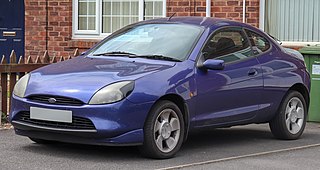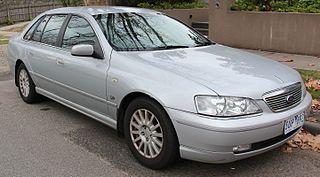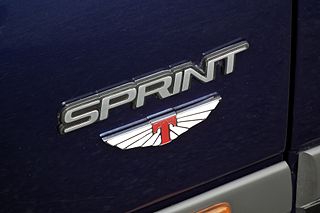
The Ford Crown Victoria is a full-size sedan that was marketed and manufactured by Ford. The successor to the Ford LTD Crown Victoria, two generations of the model line were produced from the 1992 until the 2012 model years. The Ford counterpart of the Mercury Grand Marquis, the Crown Victoria was the largest sedan marketed by Ford in North America, slotted above the Ford Taurus. The Crown Victoria Police Interceptor (1992–2011) was marketed specifically for law-enforcement use; a long-wheelbase Crown Victoria sedan (2002–2011) was marketed primarily for taxi cab fleets.

The Ford Windstar is a minivan that was produced and sold by Ford. The replacement for the Ford Aerostar, the Windstar adopted the front-wheel drive configuration of the Chrysler minivans. From the 1995 to 2007 model years, three generations of the model line were sold, with the final generation renamed as the Ford Freestar.

The Triumph Stag is a 2+2 sports tourer which was sold between 1970 and 1978 by the Triumph Motor Company, styled by Italian designer Giovanni Michelotti.

The Ford Falcon is a full-sized car that was manufactured by Ford Australia from 1960 to 2016. From the XA series of 1972 onward, each Falcon and range of derivates have been designed, developed, and built in Australia, following the phasing out of the American-influenced Falcon of 1960 to 1971, which had been re-engineered locally as the XK to XY series for the harsher Australian conditions. The luxury-oriented Ford Fairmont model joined the range from 1965. Luxury long-wheelbase derivative versions called the Ford Fairlane and LTD arrived in 1967 and 1973 respectively with production ending in 2007.

The Ford Probe is a liftback coupé produced by Ford, introduced in 1988 and produced until 1997. The Probe was the result of Ford's collaboration with its longtime Japanese partner Mazda, and both generations of Probe were derived from the front-wheel drive Mazda G platform that underpinned the Mazda Capella.

Mercury Cougar is a nameplate applied to a diverse series of automobiles sold by the Mercury division of Ford from 1967 until 1997 and from 1999 through 2002 model years. While the nameplate is associated with two-door coupes, at various times during its production, the Cougar was also marketed as a convertible, four-door sedan, station wagon, and a hatchback.

The Continental Mark V is a personal luxury coupe that was marketed by the Lincoln division of Ford Motor Company from the 1977 to 1979 model years in North America. The fourth generation of the Mark series, the model line brought an extensive modernization to the exterior and interior of the Mark IV. The Mark V introduced a sharp-edged exterior design theme, adopted by Lincoln vehicles into the end of the 1980s.

The Lincoln Navigator is a full-size luxury SUV marketed and sold by the Lincoln brand of Ford Motor Company since the 1998 model year. Sold primarily in North America, the Navigator is the Lincoln counterpart of the Ford Expedition. It is the heaviest production Lincoln ever built, and is also the Lincoln with the greatest cargo capacity and the first non-limousine Lincoln to offer seating for more than six people.

The Ford Puma is a small three-door coupé that was produced by Ford Europe from September 1997 to July 2002. The Puma was built exclusively at Ford's Niehl plant in Cologne, Germany. The Ford Puma follows common design cues with other Ford cars at the time, and is in the New Edge family of vehicles.

The Ford EXP is a sports compact coupe produced and sold by the Ford Motor Company in North America for the 1982 to 1988 model years. The EXP debuted at the 1981 Chicago Auto Show. It shared many mechanical components with the contemporary Ford Escort.

The Ford Fairlane and LTD are full-sized luxury vehicles produced in a series of models by Ford Australia between 1959 and 2007.
The Continental Mark series is a series of personal luxury cars that was produced by Ford Motor Company. The nomenclature came into use with the Continental Mark II for 1956, which was a successor to the Lincoln Continental of 1939–1948. Following the discontinuation of the Mark II, Ford continued the use of the Mark series on Continental branded vehicles from 1958 to 1960. Following a hiatus, Lincoln-Mercury relaunched the Continental Mark series during 1968 and would produce six successive generations through the 1998 model year.
Rubery Owen is a British engineering company which was founded in 1884 in Darlaston, West Midlands.

The Qvale Mangusta is a sports car produced in limited numbers by the Italian automaker Qvale between 1999 and 2002. During development and very early production, it was developed from the De Tomaso Biguá concept car shown to the general public at the 1996 Geneva Motor Show. When the car started production, it was renamed De Tomaso Mangusta before De Tomaso became disassociated from the project and all subsequent cars received Qvale badging.

The Ford Falcon (XR) is a full-sized car produced by Ford Australia from 1966 to 1968. It was the first of the second generation of the Falcon and also included the Ford Fairmont (XR), the luxury-oriented version.

The Land Rover series I, II, and III, or simply the Land-Rover are compact British off-road vehicles, produced by the Rover Company since 1948, and later by British Leyland. Though inspired by the World War II jeep, the Land Rover immediately distinguished itself from all other cars. From launch, it was the first mass-produced civilian four-wheel drive car with doors on it, and an available hard roof. Contrary to conventional car and truck chassis, it used a sturdier fully box-welded frame. Furthermore, due to post-war steel shortage, and aluminium surplus, Land Rovers received non-rusting aluminium alloy bodies, favouring their longevity. In 1992, Land Rover claimed that 70% of all the vehicles they had built were still in use.

The Land Rover Range Rover Evoque is a compact luxury crossover SUV developed and produced by Jaguar Land Rover under their Land Rover marque. The original Evoque was a development of the Land Rover LRX concept vehicle, which was unveiled at the North American International Auto Show in January 2008. The first generation Evoque was produced from July 2011 until 2018 in three and five-door versions, with both two-wheel and four-wheel drive. The second generation of the car went into production in 2018.

The Jaguar XJ (X300) is a full-size luxury sedan manufactured by Jaguar Cars between 1994 and 1997. It was the first XJ produced entirely under Ford ownership, and can be considered an evolution of the outgoing XJ40 generation. Like all previous XJ generations, it features the Jaguar independent rear suspension arrangement. The design of the X300 placed emphasis on improved build quality, improved reliability, and a return to traditional Jaguar styling elements.

Tickford Vehicle Engineering (TVE) was a company responsible for numerous automotive projects and upgrades for Ford Australia between 1991 and 2002. In 1999, TVE setup Ford Tickford Experience (FTE) as a competitor to Holden Special Vehicles (HSV). In 2002, the operations changed to Ford Performance Vehicles (FPV), coinciding with Tickford's global operations being bought out by Prodrive.

The sixth-generation Ford Mustang (S550) is the current iteration of the Mustang pony car manufactured by Ford. In departure from prior Mustang models, the sixth-generation Mustang includes fully independent rear suspension on all models, as well as an optional 2.3L EcoBoost turbocharged and direct injected four-cylinder engine. The new Mustang was introduced as a 2015 model year vehicle, marking the fiftieth anniversary of the Ford Mustang, which was revealed as a 1965 model year vehicle on April 17, 1964.



















